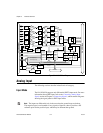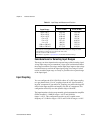
Chapter 3 Hardware Overview
NI 6115/6120 User Manual 3-8 ni.com
In low-hysteresis analog triggering mode, the trigger is generated when
the signal value is less than lowValue, with the hysteresis specified by
highValue, as Figure 3-8 shows.
Figure 3-8. Low-Hysteresis Analog Triggering Mode
The analog trigger circuit generates an internal digital trigger based on the
AI signal and the user-defined trigger levels. This digital trigger can be
used by any of the timing sections of the DAQ-STC, including the AI, AO,
and general-purpose counter/timer sections. For example, the AI section
can be configured to acquire n scans after the AI signal crosses a specific
threshold. As another example, the AO section can be configured to update
its outputs whenever the AI signal crosses a specific threshold.
Antialiasing Filters
Each AI channel on the NI 6115/6120 is equipped with a programmable
antialaising Bessel filter. On the NI 6115, you can program the filters to
provide a third-order 50 kHz lowpass filter, a third-order 500 kHz lowpass
filter, or a pass-through mode with no filtering. On the NI 6120, you can
program the filters to provide a five-pole 100 kHz low-pass filter or
pass-through. These Bessel filters are highly effective at reducing signal
aliasing and are designed for use with software filters.
Existing software algorithms alone provide good roll-off at the cut-off
frequency as shown in Figure 3-9. However, aliasing can cause
high-frequency harmonics to make it through passbands in the filter. By
combining hardware and software filtering, it is possible to obtain both
steep roll-off and clean filtering of high-frequency aliases.
highValue
Trigger
lowValue


















